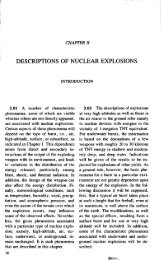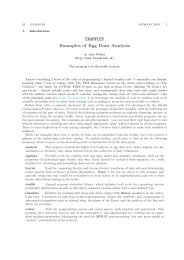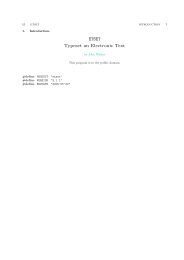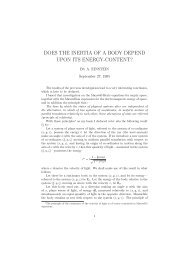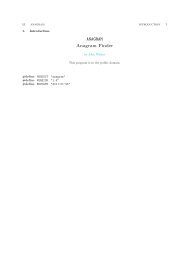The Annoyance Filter.pdf - Fourmilab
The Annoyance Filter.pdf - Fourmilab
The Annoyance Filter.pdf - Fourmilab
You also want an ePaper? Increase the reach of your titles
YUMPU automatically turns print PDFs into web optimized ePapers that Google loves.
§182 ANNOYANCE-FILTER TOKEN PARSER 155<br />
182. <strong>The</strong> messageQueue can be used to store the lines of a message: “what the parser saw,” after<br />
MIME decoding (but not elision of HTML comments or other processing in the parser itself). This is<br />
handy when debugging the lower level stuff. To enable saving messages in the queue, call setSaveMessage<br />
with an argument of true . <strong>The</strong> contents of messageQueue may be examined directly (it is a public<br />
member of the class), or written to an ostream with writeMessageQueue . One little detail—if you<br />
examine the messageQueue after the start of the next message in a folder has been detected, the first<br />
line of the next message will be the last item in the message queue; writeMessageQueue understands<br />
this and doesn’t write the line, but if you’re looking at the queue yourself it’s up to you to cope with<br />
this.<br />
〈 Message queue utilities 182 〉 ≡<br />
void setSaveMessage (bool v)<br />
{<br />
saveMessage = v;<br />
source ⃗ setDiagnosticList (saveMessage ? (&messageQueue ) : Λ);<br />
}<br />
bool getSaveMessage (void) const<br />
{<br />
return saveMessage ;<br />
}<br />
void clearMessageQueue (void)<br />
{<br />
if (saveMessage ) {<br />
string s;<br />
}<br />
}<br />
if (isNewMessage ( )) {<br />
s = messageQueue .back ( );<br />
}<br />
messageQueue .clear ( );<br />
if (isNewMessage ( )) {<br />
messageQueue .push back (s);<br />
}<br />
void writeMessageQueue (ostream &os )<br />
{<br />
list〈string〉::size type l = messageQueue .size ( ), n = 0;<br />
for (list〈string〉::iterator p = messageQueue .begin ( ); p ≠ messageQueue .end ( ); p++, n++) {<br />
if (¬((n ≡ (l − 1)) ∧ (p ⃗ substr (0, (sizeof messageSentinel ) − 1) ≡ messageSentinel ))) {<br />
os ≪ ∗p ≪ endl ;<br />
}<br />
}<br />
}<br />
This code is used in section 173.





